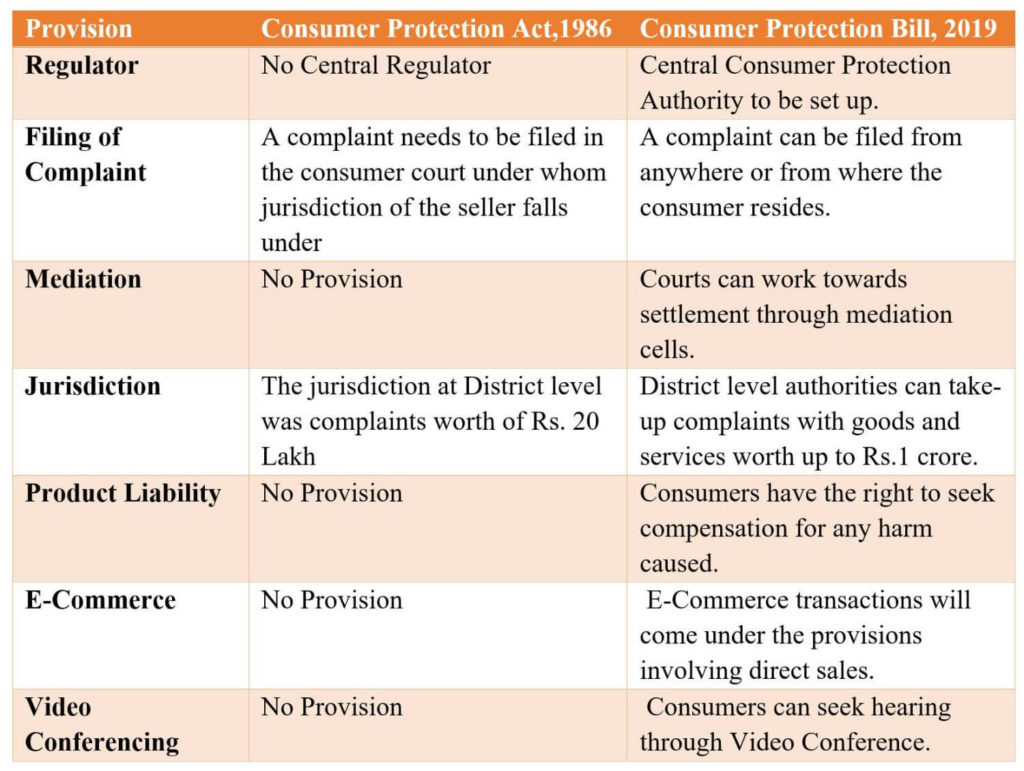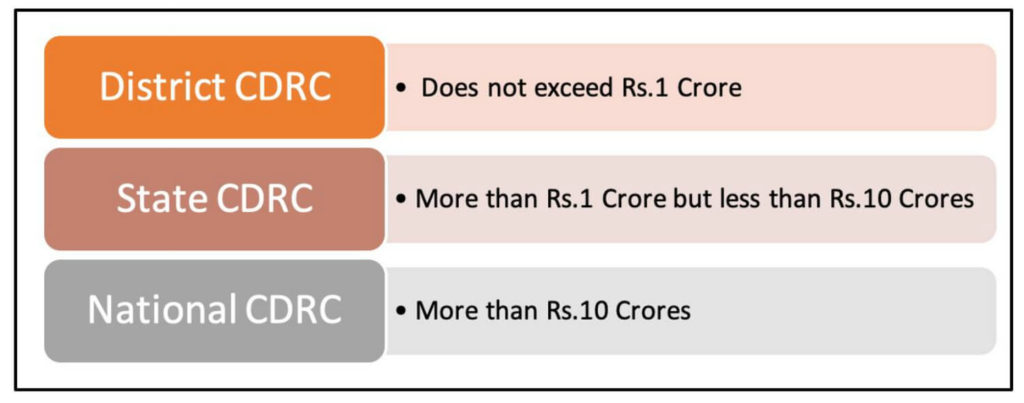[orc]The Consumer Protection act, 2019 was recently passed by both houses of parliament. How does this differ from the 1986 act and what is in it for the consumers? Here is an explainer.
The new Consumer Protection bill was passed by the Parliament on 06 August 2019 when it was passed through a voice vote in the Rajya Sabha. The bill was earlier presented and passed in the Lok Sabha on 30 July 2019. This bill would replace Consumer Protection Act, 1986.
But how is the new act different from the 1986 act? We look at some of the important aspects of the 2019 act and how consumers can benefit from these provisions.
Central Regulatory Authority & Product Liability among key features of the new act
Consumer Protection Act, 2019 has proposed certain new provisions which were not part in the earlier Consumer Protection Act, 1986. Few of the key provisions which vary from the earlier Consumer Protection act are the following

What are the Rights of the Consumers?
The new bill has defined 6 rights of the consumers. Which include:
- Right to be protected against the marketing of goods, products or services which can be hazardous to life and property
- Right to be informed about the quality, quantity, potency, purity, standard and price of goods, products and services
- Right to be assured of access to goods, products and services at competitive prices.
- Right to be heard at appropriate forums
- Right to seek redressal against unfair trade practices that are involved in exploitation of customers
- Right to consumer awareness
What is the role of the Central Consumer Protection Authority?
One of the important provisions of the new act is the proposal to set up a Central Consumer Protection Authority (CCPA) by the Central Government. The stated purpose of CCPA would be ‘to promote, protect and enforce the rights of the consumers.’
An investigative wing headed by a Director General would conduct inquires and investigations into any violations relating to consumer rights, unfair trade practices and misleading advertisements. The earlier Consumer Protection Act, 1986 did not have any such provision for a regulator.
The important functions of CCPA would include:
- Inquiring into consumer rights violations.
- Investigating these violations and proceeding with prosecution as appropriate
- Pass orders to recall any goods or withdraw services that are deemed to be hazardous
- Issue orders in regard to reimbursement of the price paid by customers for such services
- Issues directions to the appropriate personnel in regard to any false or misleading advertisement to either discontinue or modify it
- Imposing penalties in respect to any violations
- Issues notices to educate consumers in regard to unsafe goods and services.
In the statement of objects & reasons of the new bill, it is mentioned that the ‘establishment of an executive agency like the CCPA to promote, protect and enforce the rights of consumers; make interventions when necessary to prevent consumer detriment arising from unfair trade practices and to initiate class action including enforcing recall, refund and return of products, etc. fills an institutional void in the regulatory regime. Currently, the task of prevention of or acting against unfair trade practices is not vested in any authority. This has been provided for in a manner that the role envisaged for the CCPA complements that of the sector regulators and duplication, overlap or potential conflict is avoided.’
Then what about the Consumer Disputes Redressal Commissions?
Like in the case of the 1986 act, Consumer Disputes Redressal Commissions (CDRCs) would be setup at various levels. The CDRCs would be set up at multiple levels – district, state and national.
Consumers can file complaints with the CDRCs regarding any of the following.
- Defective goods or services
- Overcharging or deceptive charging on goods and services
- Any unfair or restrictive trade practices
- Offering services or sale of goods which can be hazardous to life or not safe
Complaints for all these can be filed in the district level CDRCs and all these complaints can be made online (electronically).
Jurisdiction of CDRCs: Each of these levels of CDRCs have varying jurisdiction based on the value of goods and services for which the complaint is being made.

What is the appellate process?
The parties involved in the complaint have the right to appeal in the higher forums in respect to any ruling provided in the respective CDRCs.
- Any appeals from the district CDRC would be heard in the State CDRC.
- Appeals from State CDRCs would be taken up in National CDRC.
- The final appeal beyond National CDRC would be taken up by the Supreme Court.
What about product liability?
Product Liability is a key aspect introduced in this bill that would benefit the consumers. Under the provisions of this bill, a manufacturer or a service provider would be required to compensate the consumer in case of any loss or injury due to a manufacturing defect in the product or a poor service.
This differs from the existing provision where only the cost of the product was compensated by the manufacturer or the service provider and not the cost of the loss or injury as in the current proposal. The provision for seeking compensation for the loss or injury was only through the civil courts, which have been observed to take a long time to resolve.
E-Commerce would also be covered
E-Commerce has been gaining traction over the past few years and Consumer Protection Act, 1986 does not have any provisions to deal with these transactions. As per the new act, all the laws that apply for direct selling would also be applicable for E-Commerce.
One of the key guidelines in this regard is that the E-Commerce platforms (Amazon, Flipkart etc.) are required to disclose the details of the sellers. Apart from the manufacturers, product liability would also include the sellers as well as the service providers i.e. the e-commerce aggregators.
Guidelines regarding Misleading advertising and Endorsers
The bill lays down guidelines for any misleading advertisements for a product or service which effects the consumer. It could lead to a prison term of two years and a fine which can be up to Rs. 10 Lakhs. Any subsequent offence could lead to an imprisonment of up to 5 yeas and a fine extending to Rs. 50 Lakhs.
The new bill, has provisions which allow CCPA to fix the liability even on the endorser of any misleading advertisement. It can also prohibit an endorser from making endorsement for any product or service for a period of one year if found necessary. Any subsequent violation could result in prohibition from endorsing any product or service for a period of 3 years. This is expected to make the brand ambassadors exercise due diligence on the veracity of the claims being made about a product or a service before choosing brands to endorse.
The bill simplifies consumer litigation and takes cognizance of emerging trends, but implementation remains a challenge
The electronic filing of complaints & permission to attend the hearing through video conference are very important steps in simplifying the process of complaints. Further, the idea of mediation could also help in quicker disposal of cases. With the inclusion of E-commerce under the gambit of consumer laws, the bill takes cognizance of the emerging trends in the marketplace.
However, it remains to be seen how all the new provisions will be implemented since it will require augmenting the physical & human resources at every level and that will require additional allocation of funds both by the Central & State Governments.
Featured Image: Consumer Protection Act, 2019



2 Comments
Pingback: Explainer: What is new about the Consumer Protection Act, 2019? - Fact Checking Tools | Factbase.us
In Army a joke is universally goes around to buttress the view that local orders supersede all written orders and verbal orders of the commanders at levels are supreme.
Second joke is about Bhoop Singh the universal character of an Infantry soldier on duty at the border.
Placing of Medium Machine Gun were being revised based on intelligence inputs received at the highest level. Havaldar Bhoop Singh and all others in charge of manning the MMGs were briefed and place the Gun at a particular direction. He was ready pointing his Gun as per his assessment. His Platoon Commander visited and asked him to place the Gun a bit differently. He positioned the Gun accordingly. Next came the Company Commander and the Batalion, Brigade and Div Commanders. Each time Hav Bhoop Singh had to shift or adjust his Gun according to wishes of the respective Commanders up the chain. Finally the inspection was over. Hav Bhoop Singh positioned the MMG to his original position. When asked by his Junior in Arms Hav Bhoop Singh replied “I have to face the Enemy and not them”.
My experience with State and National Redressal Commission for the past 4 years is that it is the Hav Bhoop Singhs in the Rwgistry who decides the procedures and even hold Kangaru Courts to decide on issues beyond their jurisdictions and cause delay with a motive to accrue pecuinary benefits from the Companies in Dispute.
Unless we are able to change the whole concept of placing retired Government Servants including Judges keeping the Registry packed with people who are there to tow the line of the govt of the day sometimes even overpowering the presiding officers of the commission all such empowering tools and amdt will remain in paper.
Jai Hind.